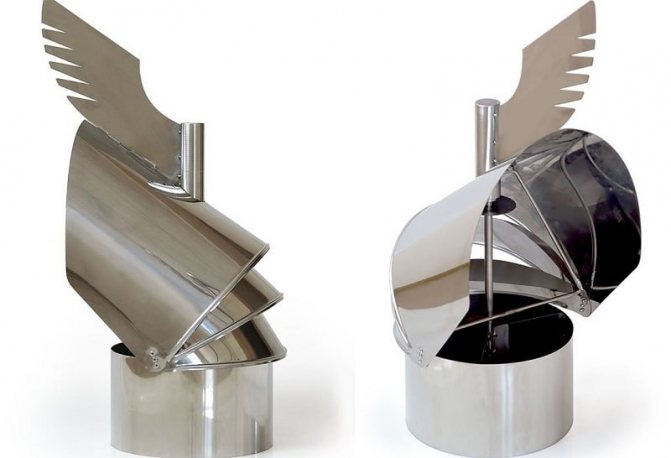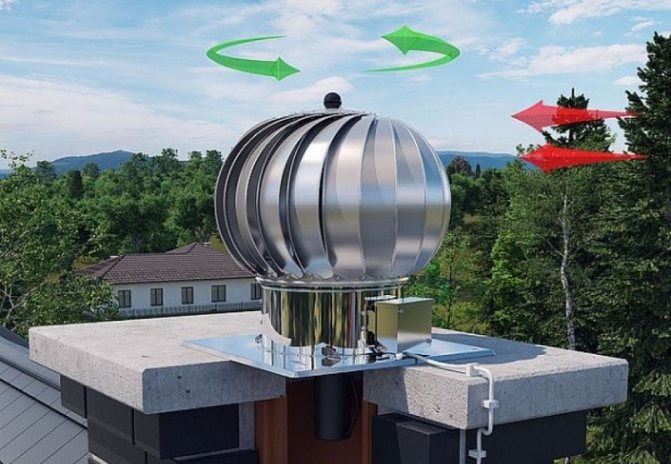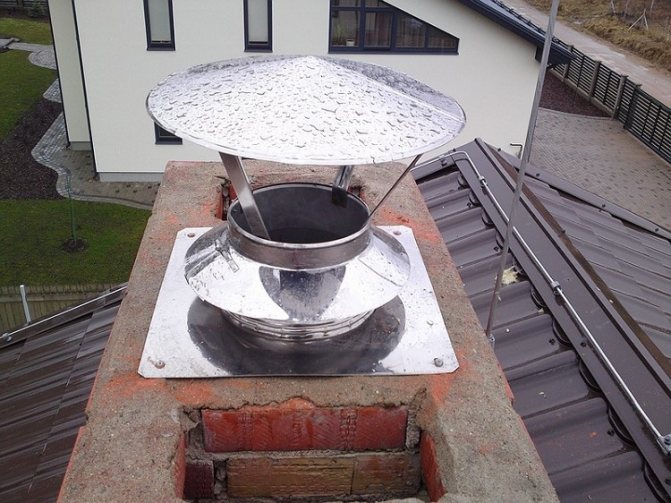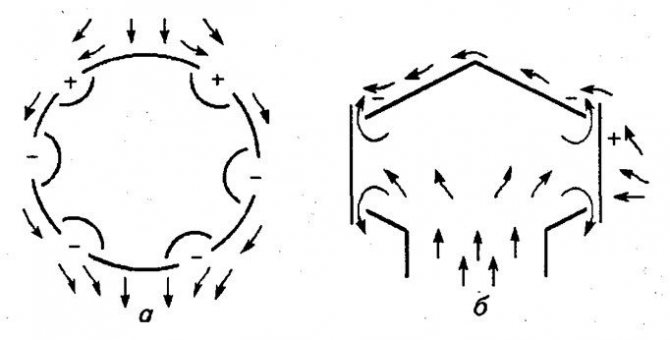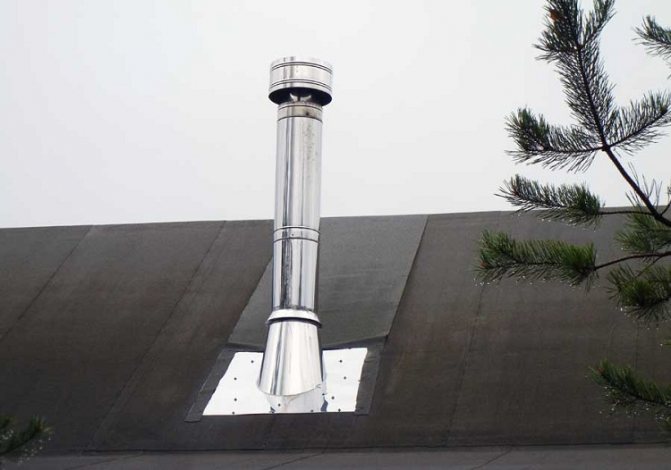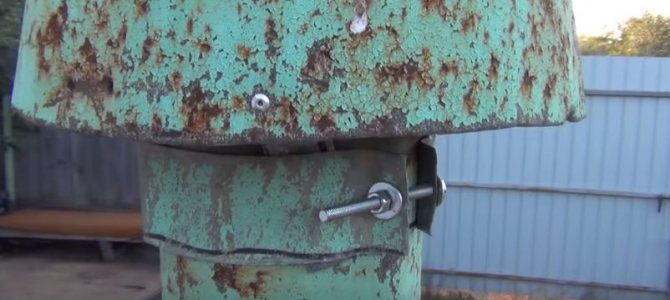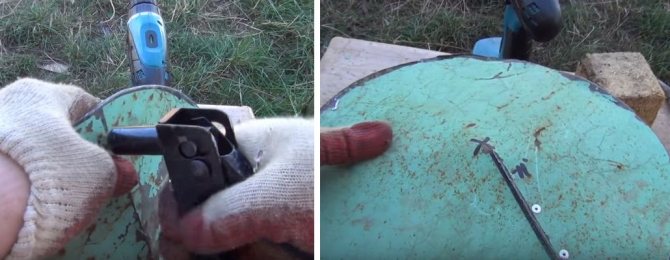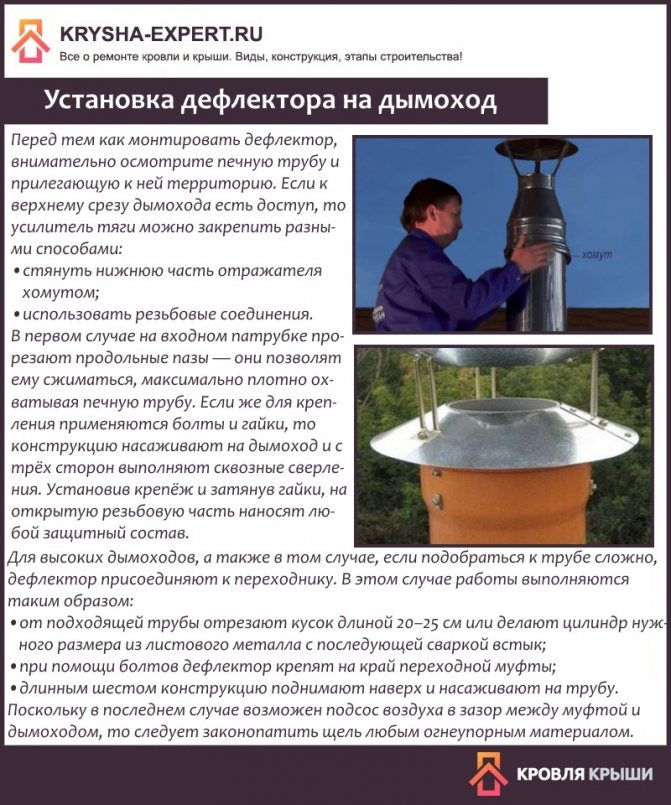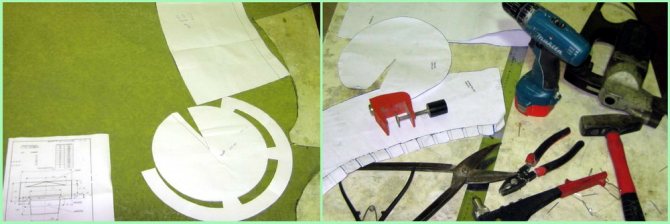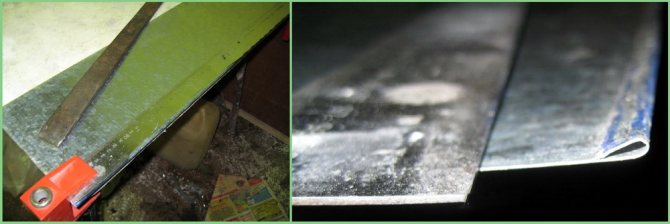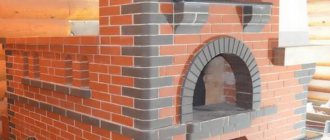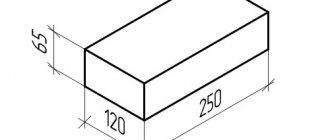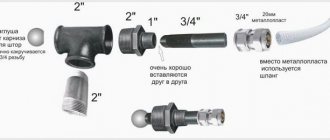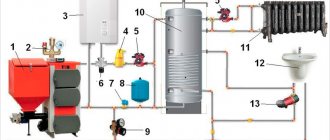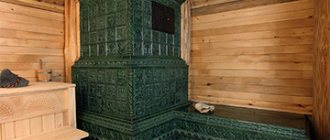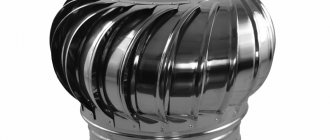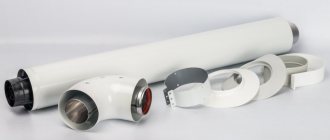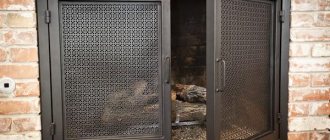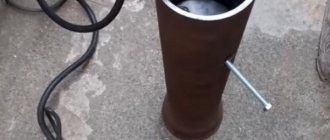Main page »Construction» Roofing works
Experienced craftsmen know that it is not enough to fold the stove well - it is equally important to build a chimney that can provide good draft. For a number of reasons, the chimney may not work efficiently enough, and the acceptable initial characteristics begin to decline over time. It is not difficult to prevent such troubles - it is enough to equip the chimney with a deflector. This simple device will not only improve its aerodynamic properties, but also protect the smoke channel from debris and precipitation.
- Varieties and design of modern deflectors
Deflector TsAGI
- Grigorovich-Volpert's reflective chimney
- H-shaped reflector
- Disc deflector
- "Volper"
- Constructions with a weather vane
- Spark arrester deflector
- Recommendations for choosing a traction amplifier
Table: dependence of the parameters of the chimney on the diameter of the metal chimney
- Video: chimney deflector is an excellent solution to increase traction and protect against wind
Purpose
So, the tsagi deflector is designed to increase the draft of the chimney or ventilation system. Its principle of operation is as follows: it is known from the laws of physics that warmer air is lighter than cold air. If the air heats up from below, then unheated air begins to press on it from above, since its mass is greater, respectively, the warm flow rises up. The usual chimney system is based on this, that is, smoke, like more heated air, rises up by gravity. However, it is hindered by colder air, since the chimney is a closed system. So, in order to reduce this pressure of cold air, that is, to reduce the resistance, a deflector is installed that cuts the air flow, thereby establishing a low pressure area (vacuum area) above the chimney or ventilation pipe. This naturally increases cravings.
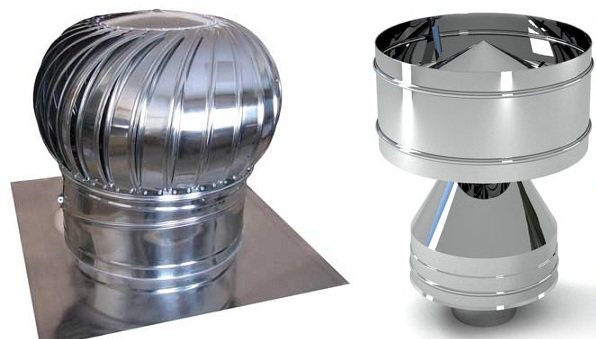
Deflector tsagi
Strengthening the draft contributes to the fact that the efficiency of the device that underlies, for example, if we are considering a chimney, then it may be a stove, increases by 20 percent. This means that the combustion process will be much better without the use of additional amounts of combustible substances.
From all this, we can conclude that the tsagi deflector is intended only to increase thrust. However, there is a special group of such devices. These are rotary products. Their essence lies in the fact that the central part rotates, which creates an even greater rarefaction of the air around, respectively, and the thrust increases.
Such deflectors also serve for forced ventilation, removal of gases and vapors from the room.
Chimney problems and the purpose of the TsAGI-type deflector
A well-equipped chimney with natural draft, as a rule, copes quite successfully with its dual purpose:
- remove by-gaseous products released during the combustion of fuel in the heating device;
- provide the necessary flow of atmospheric air for better traction.
Note! In the operation of chimneys that do not have forced airflow, malfunctions are possible when the natural draft and the correct functioning of the chimney and the heating device as a whole are disturbed.
Such failures can be caused by:
- errors in design, when an excessively narrowed smoke passage cannot provide the required level of natural draft;
- errors during installation, when the chimney was not raised to a height sufficient to generate the necessary pressure and gravity in it;
- strong gusts of wind, in which air entering the chimney interferes with natural draft, which can lead to smoke in the room and even stop the operation of the heating device.
The deflector, developed by specialists of the Central Aerohydrodynamic Institute, effectively solves the most important problem in the operation of chimneys and ventilation systems of natural induction. It becomes an obstacle in the path of the wind flow, not allowing it to pass through and creating an area of reduced pressure. The mass formed in the ventilation or chimney channel rushes to the area with rarefied air, where the level of natural draft increases in this way.


With the help of a deflector, you can increase the draft in the chimney, if for some reason it is insufficient
By installing the TsAGI deflector, it is possible to get rid of problems in the operation of the natural ventilation system or chimney, along the way solving some other problems:
- raise the level of natural draft in a chimney or ventilation system, working on the principle of natural induction;
- do not allow back draft even with a large diameter of the air outlet;
- prevent atmospheric precipitation from entering the system;
- act as a spark arrestor, increasing the level of fire safety;
- protect the chimney or ventilation from the possibility of rodents and insects, small birds, dust, leaves and other debris;
- to slow down the process of destruction of the chimney head.
Product design
If you plan to make a tsagi deflector with your own hands, then it will not be superfluous to consider its design, that is, to install all the individual parts that make up it:
- Lower cylinder or branch pipe. It will be attached to the end of the ventilation system duct or the end of the chimney pipe;
- Diffuser. This part is represented by a widened cone that goes from the nozzle to the top of the product;
- Branch pipe or shell. This is the outside of the device;
- Cap or top cone. The part that is attached to the top of the entire structure and protects the ventilation or chimney systems from rainfall;
- Legs for attaching the cap;
- Brackets for attaching the entire device.
Tsagi deflector circuit
It must be said right away that all these elements are made by hand from galvanized sheet or stainless steel. These materials can be found in sheet form at all hardware stores.
What is a deflector and its assembly
The word "deflector" is taken from Latin, where "deflecto" is translated as "deflect" - this is an imperfect verb from which the name of the device originated. Any of these structures was created on the basis of the law of conservation of energy (Bernoulli's law) and in this case it is expressed in the equalization of air pressure, which is different at a given temperature.
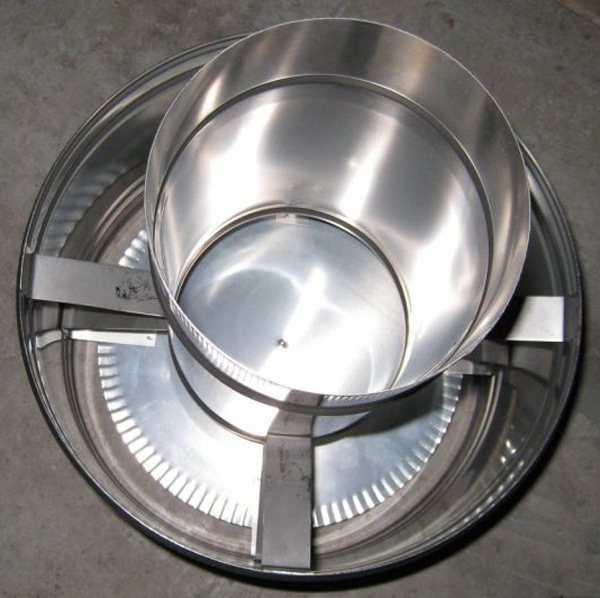

This is how the device looks from below
In practice, the Volpert-Grigorvich deflector is installed on the upper part of the chimney, and even with a light breath, the wind flows around the walls of the device and the air inside it becomes rarefied and colder. The air mass from below rushes up to the zone of reduced pressure, which is called thrust.
The Volpert-Grigorvich deflector in action - an incredible effect
Device
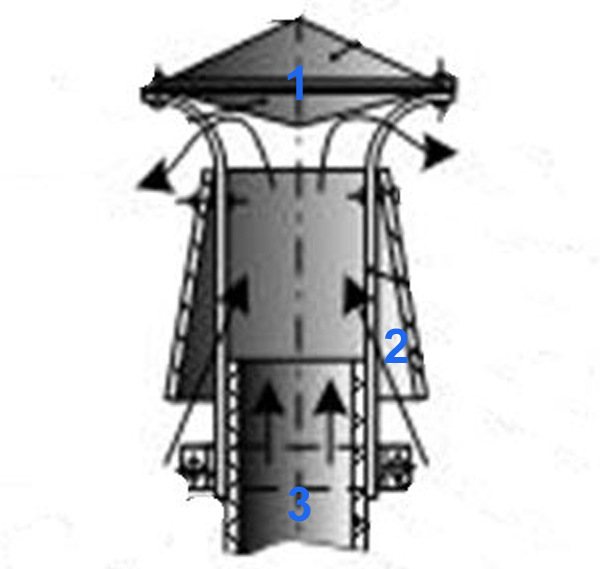

Components of the Volpert-Grigorovich deflector
This deflector was created on the basis of two developments - the connection of the Volpert device with the Grigorovich device. It is unusually simple (see image above) and generally consists of only three elements:
- Double-sided cone umbrella cover.
- Trapezoidal diffuser (lampshade).
- Trumpet.
In the upper image, the arrows indicate the movement of the wind - blowing on the pipe, it enters the diffuser and. naturally, it rises up, where it is reflected on the sides by the reverse cone of the cover or umbrella (call it what you want). It turns out that in the inner space of the diffuser above the pipe, the air is constantly rarefied, which makes the gases from the burnt fuel (smoke) or air from the room rush up the pipe - the suction effect arises.
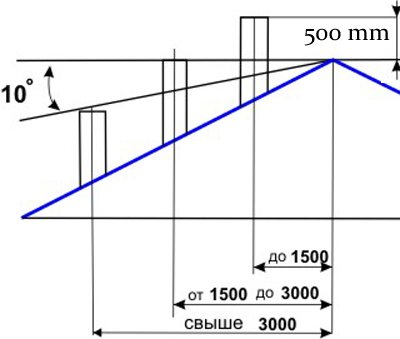

The principle of the location of the chimney on the roof slope
Here it will not be superfluous to point out the location of the chimney (ventilation) on the roof slope so that your product and its installation will be useful. The upper drawing shows the principle of the correct positioning of the chimney in relation to the height of the ridge. For example, if the second and third options (from right to left) are made lower, then the deflector will not bring much benefit. Therefore, if your chimney is shorter than necessary, then it should be raised with a fragment of a metal, ceramic or asbestos-cement (chrysotile-cement) pipe.
Materials and tools for work
To make a deflector, you will need the following materials:
- galvanized sheet metal (it is better to choose the thickness not 0.25 mm, but 0.32 mm);
- duralumin rivets or small bolts with nuts;
- steel strip for brackets (no thicker than 1-1.5 mm);
- fasteners (there can be plastic dowels with self-tapping screws for a brick or ceramic chimney).
From the tools you need to prepare:
- scissors for metal (you can use a grinder with a cutting disc);
- ruler (can be replaced with a level or a rule);
- scribe or marker, tape measure;
- school compasses;
- riveter;
- cordless and / or electric drill;
- extension cord for connecting a drill on the roof.
Getting Started
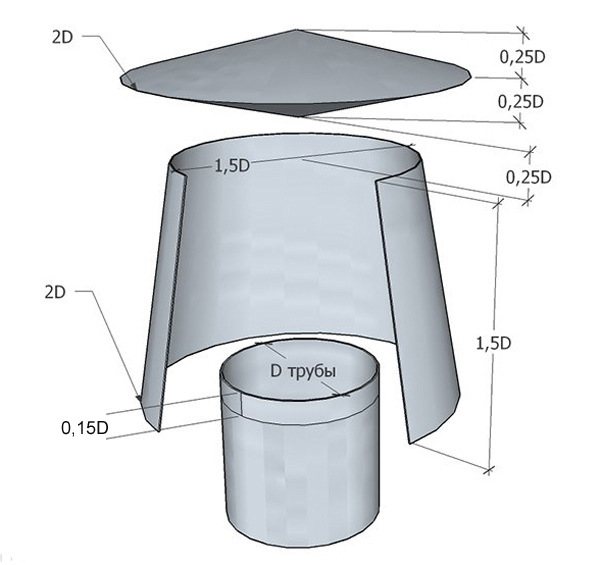

This is the structure to be made of galvanized sheet.
To make calculations, you need to pay attention to the top image - there all dimensions are tied to the diameter of the chimney or ventilation pipe, therefore, to make it clearer, we will do such calculations for a Ø200 mm pipe. If the height of the lampshade and its upper diameter is one and a half times larger, then these values will be 200 * 1.5 = 300 mm each. The lower diameter of the lampshade is 200 * 2 = 400 mm. The overlap of the lampshade on the pipe is 200 * 0.15 = 30 mm. The height of each lid cone is 200 * 0.25 = 50 mm, for a total of 50 + 50 = 100 mm. The diameter of the umbrella is 200 * 2 = 400 mm. The height from the bottom of the cone (peak) to the lampshade is 200 * 0.25 = 50 mm.
Note. The chimney or ventilation may have a different diameter, so for calculations you can independently substitute the required value instead of 200 and get the results that are suitable in your case.
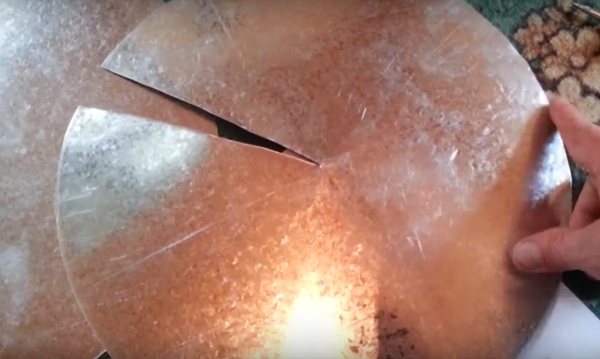

First, a round disc is cut out and a triangular cut is made in it.
We turn to the process of manufacturing a device to optimize the combustion process and start with the lid (we will start from the same 200 mm. First, you need to draw a circle on the tin, but such a large compass cannot always be found, so we will make it from available tools - a thin rail and a self-tapping screw. In the corner of the galvanized sheet, determine the approximate center and screw a bar there, on which, stepping back from the fixation point of 100 mm (radius), drill a hole, insert a scribe there and draw a circle.Cut it out and make a similar copy for the opposite side.
To set the required height of the cone, you will have to cut a wedge from the resulting circle, and for this you need to divide the circle into 36 parts - this is not difficult. First, calculate the length of the chord, which is equal to the diameter multiplied by a factor (for 36 parts, k = 0.08716). This means that 200 * 0.08716 = 17.432≈17 mm. We do not need to mark the whole circle - two marks at a distance of 17 mm are enough, from which we draw lines to the center with a scribe, and then cut out the marked wedge.
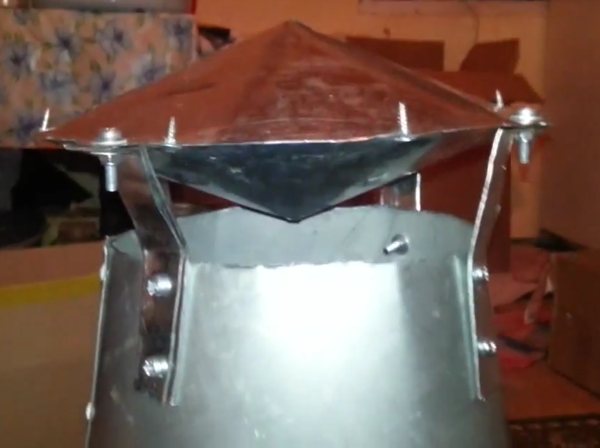

Reversible umbrella attaches to cone diffuser lampshade
Pull the cut edges with an overlap and rivet with aluminum rivets or fasten with small bolts, although rivets are both more convenient and aesthetically pleasing. In the same way, make the opposite part of the cover, after which you connect both umbrellas with the fasteners of your choice into one disk, as in the photo above, and proceed to making a cone diffuser.
Now, based on the ratio of the diameter (in this case, we have Ø200 mm) to the rest of the values, we cut out a strip 300 mm wide (height), and the length can be calculated using the formula C = πd, where C is the desired circumference, π = 3.14 , d = 200 mm (in our case). This means that the length of the lower circle C = πd = 3.14 * 400 = 1256 mm and 5 mm will be added to the overlap when joining, and the length of the upper circle C = πd = 3.14 * 300 = 942 mm. First, we cut out a strip of 300 × 1261 mm, but since the difference in the circumference is 1256-942 = 314 mm, we divide this number in half and retreat from each side by 314/2 = 157 mm. Cut off the edges and get a trapezoidal quadrilateral. We rivet it with an overlap of 5 mm and proceed to the assembly of the device.
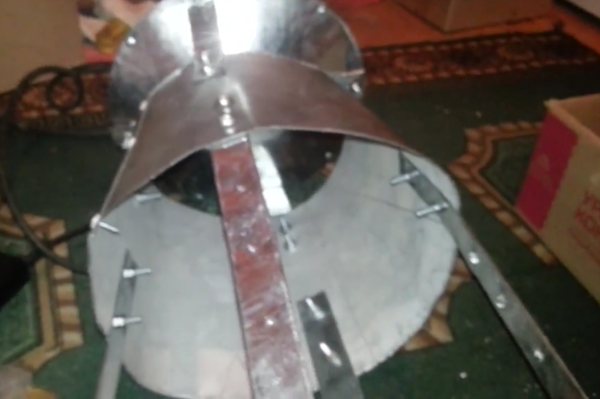

Attaching the installation feet to the deflector
It remains to fix the double-sided umbrella to the diffuser lampshade and make the fixing legs for the final installation of the optimizing device. It is best to cut the strip from sheet metal of a suitable thickness (1-1.5 mm), since it is unlikely that it will be possible to purchase such a format at any metal warehouse - they usually offer no thinner than 2 mm, although this can also be used.
First, attach the cover to the lampshade on three or four brackets so that the peak of the cone is at a distance of 50 mm from the diffuser - fix the strip with the same fasteners (rivets or bolts). Then attach three or four legs to the diffuser so that you can make a 30mm overlap on the pipe.
Now all that remains is to install a deflector on the chimney or ventilation, and this, perhaps, for a beginner may be a difficult operation, since you will have to work at a height. But in any case, even a person with a trained vestibular apparatus will not interfere with insurance - the best option is a mounting belt, but you can simply tie yourself around the waist to a pipe. The fastening technology will depend on the material from which the vertical chimney or exhaust ventilation is made.
So you can make a Volpert-Grigorovich deflector with your own hands
Self-production
So, in order to make a tsagi deflector with your own hands, you must calculate it in advance. To do this, you should know some of the technical characteristics that such devices may have:
- Deflector shape;
- Manufacturing material;
- Deflector dimensions;
- His type.
Since we have decided on the type - this is the device of the tsagi of the design described above, it remains to decide on all the other parameters of the future self-made deflector.
So, the calculation begins with the establishment of the desired form. Everything is simple here. The shape of the deflector directly depends on the shape of the pipe on which it is made. Next, we decide on the material. Here, too, everything should be clear, since the optimal materials for do-it-yourself work were proposed above.
The next step is to determine the dimensions of the deflector. They, like the shape, directly depend on the size of the chimney or pipe of the ventilation system.
To simplify the calculation, you can take all the necessary dimensions from the table:
Popular product types
You've probably noticed that they come in various shapes. Modern devices can have different tops:
- Flat
- Semicircle
- With lid
- With a gable gable roof


Semicircular cap
The first type is most often installed on houses made in the Art Nouveau style. For ordinary modern buildings, a semicircular hood is mainly used. The deflector gable roof does the best job of protecting the chimney from snow.
Chimneys are mainly made of galvanized iron, less often of copper. But today, products coated with enamel or heat-resistant polymer are becoming fashionable. If the device is used on ventilation ducts where there is no direct contact with heated air, then a plastic hood can be used.
Deflector designs are also different.
In the domestic market, the most popular are:
- Deflector TsAGI, spherical with rotation, open "Astato"
- Grigorovich's device
- "Smoke Tooth"
- Round chimney "Voller"
- Star "Shenard"
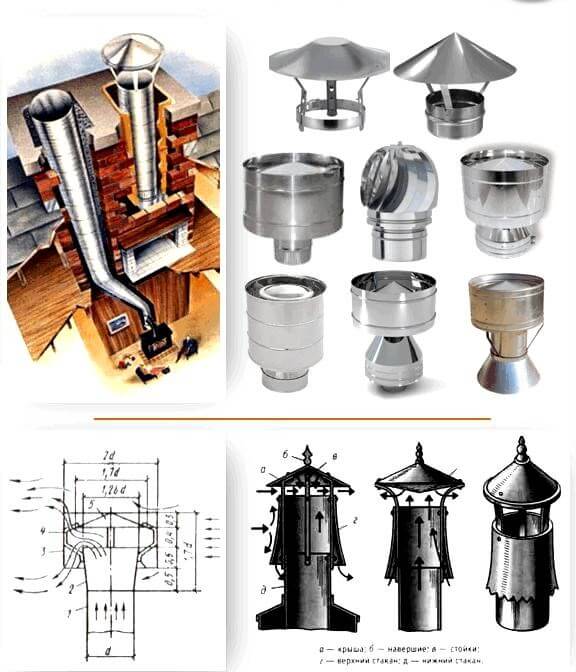

Various options for chimney hoods
The TsAGI deflector became the most popular in the Russian open spaces. Its package includes:
- Branch pipe (inlet)
- Frame
- Diffuser
- Umbrella
- Brackets
You can buy a factory deflector and install it on the chimney, but some people prefer to make it themselves from scrap materials. To do this, you should adhere to a few simple rules.
Dimensions of the tsagi deflector
| № | inner diameter, mm (d) | deflector height, mm (H) | diffuser width, mm (D) |
| 1 | 120 | 144 | 240 |
| 2 | 140 | 168 | 280 |
| 3 | 200 | 240 | 400 |
| 4 | 400 | 480 | 800 |
| 5 | 500 | 600 | 1000 |
This table shows the dimensions, the designation of which can be seen in the following image:
Designation of the dimensions of the tsagi deflector
Since not all possible size options are presented in the table, when calculating, the following rules should be taken into consideration:
- The optimal height for the product is considered to be one that fits into the interval from 1.6 to 1.7 from d;
- The diffuser width should be between 1.2 and 1.3 d;
- The width of the protective cap is from 1.7 to any convenient value from d.
So, when the calculation is done, then you can start designing. Drawings for yourself are best done on a large scale.
If there is no experience in working with metal, and there is no confidence in the correctness of all calculations, then it is better to train in manufacturing on cardboard. First, all the details are cut out of it. And only then these details, like a cliche, are superimposed on a sheet of metal and cut out.
As for fastening parts to each other or individual parts in parts, this can be done using bolts with nuts or rivets.
All operations with metal are best done with a grinder or metal scissors. At the same time, do not forget about safety precautions - you need to work only with gloves and goggles.
What is the deflector for?
A deflector is a device that blocks external influences on the chimney. It prevents various debris from entering the pipe and blocks air flows. The standard type deflector consists of three essential elements: a cylinder, a diffuser and a protective cap. The protective cap prevents any objects from entering the chimney.
The cylinder reduces the intensity of wind currents. The air currents hit the cylinder and partially rise upward. As a result, the wind captures the combustion products that come out of the chimney, which several times improves the draft of the chimney. Since the streams move in a straight line, no turbulence is created. As a result, carbon monoxide is completely removed out of the chimney. This effect is due to Bernoulli's gas law. In a channel with a decreasing cross-section, the velocity of gas movement increases, while the pressure drops. Once in a low pressure area, the air flow accelerates the removal of substances. In the case of a deflector, smoke.
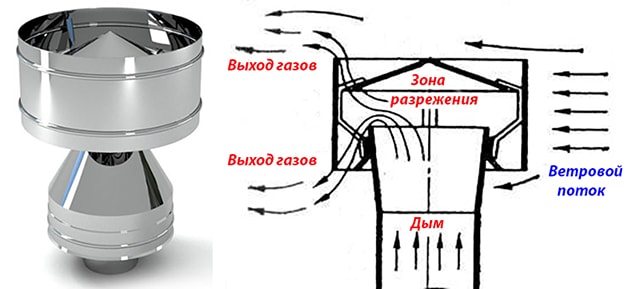

The principle of operation of the deflector
Deflectors are installed on the chimney as a protective device against external factors. It performs several functions:
- prevents the appearance of back draft during strong winds, due to which smoke can enter the room;
- protects the pipe from the ingress of foreign objects such as leaves, debris or bird nests;
- prevents precipitation from entering the chimney;
- contributes to the unimpeded escape of combustion products from the pipe;
- prevents the flame from fading in the furnace;
- provides an increase in thrust up to 20%, due to which the coals burn out better.
During the construction of a chimney, many factors are taken into account. The calculation of the channel diameter, pipe height and cross-sectional shape is carried out taking into account that the thrust is maximum. But it is impossible to foresee all situations.Strong gusts of wind can create a back draft in the chimney, the necessary pressure difference will disappear, due to which the combustion products will not penetrate through the chimney. The deflector helps to prevent the occurrence of all these phenomena.
Installing a deflector on the chimney pipe is desirable for any type of stove.
Do-it-yourself tsagi deflector
| Author | Share | Rate |
| Victor Samolin |
Interesting on the topic:
The principle of operation and manufacture of ventilation deflectors
What exhaust technology to choose for your home
Three main technologies for installing a kitchen hood
Comments on this article
Sanya Kalyuzhny, Kharkiv thanks, I will make a deflector
09/18/2015 at 17:27KasparSn Thanks for the dimensions shown! The deflector for these coefficients turned out to be excellent, copes with its task without any complaints. 02/05/2016 at 15:59
Jordanbowl I made a cardboard deflector according to your plate. Everything worked out. It remains only to repeat on a stainless steel sheet. 04/13/2016 at 11:36
Arthur Now we are using a chimney without a nozzle. Is there any data on how much the efficiency of the thermal device will increase when installing the deflector? 05/10/2016 at 23:33
Gorin Hello! If you choose the right size and type of deflector, then the efficiency of the heating unit increases by about 20%. But this is not the only benefit, since the deflector still serves as protection against the ingress of precipitation and debris into the chimney. 05/11/2016 at 17:35
Deflector Grigorovich
It is a further development of TsAGI and is better suited for installation in places where ascending air currents prevail. In addition, it provides optimal performance even in the absence of wind, without creating perceptible resistance. In the lower part, the deflector is a high truncated cone with an expansion in the lower part. It starts at the chimney mouth with an overlap up to a third of its height.
The gases from the pipe itself enter the narrowing channel of the diffuser, and thereby cause a vacuum. The upward currents of the outside air further enhance the effect by increasing traction.
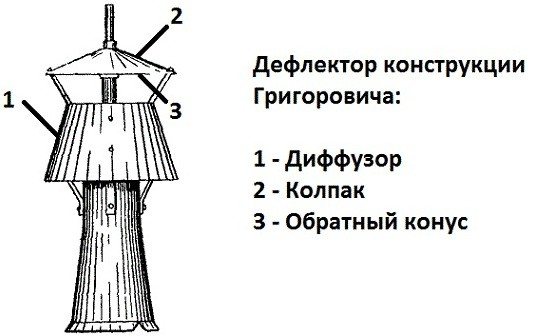

Device and principle of operation
The deflector is an aerodynamic device that is mounted on top of the ventilation duct, chimney. Its role is to enhance traction.
A standard chimney deflector consists of a cylinder, a diffuser, a protective cap. Also, the device is equipped with annular rebounds located at the bottom around the diffuser.
The operation of this device is based on Bernoulli's law. Its essence lies in the fact that the faster the air flow moves when the cross section of the channel changes, the lower the static pressure in this section.
Thus, the deflector installed on top of the chimney is an obstacle to air. At the moment when the wind touches the walls of the cylinder, it loses its strength and breaks up into a large number of small air currents, the power of which is very low. Some of them move along the hull and mix with the smoke that is discharged from the chimney. Thanks to this process, the draft in the chimney becomes greater. Another important function of the deflector is that it does not allow debris, snow, and rain to enter the channel.
Varieties
Many users constantly ask themselves: which deflector is better for the chimney? To answer this question, you need to study the existing models and, based on their characteristics, choose the most optimal option.
Today there are several types of deflectors that have gained popularity due to their practicality and reliability.
Dish-shaped Astato. This deflector is open but very effective. Its main distinguishing feature is that it is able to provide good traction, regardless of which direction the wind is blowing. Manufacturing material - galvanized / stainless steel.
Chimney deflector plate Astato
Deflector TsAGI. This model is recognized as one of the most popular and demanded. It is made in the form of a cylinder. The material of manufacture is stainless or galvanized steel. Connection type - flanged.
Round Volper. In terms of design features, this model resembles the previous one. The main feature is the top of the device. Usually such deflectors are made of stainless steel or copper. Most often they are purchased for installation on a bath chimney.
Deflector Grigorovich. This type is a more modern and improved version of TsAGI. It is installed in places where the winds are generally not very strong.
H-shaped. This model is distinguished by its high strength and reliability, regardless of the direction of wind movement - it is effective. H-shaped stainless steel deflector is made. The connection is made by means of a cut-in on the device branch pipe.
Deflector-weather vane. It is a rotating body with a weather vane on top. Made of stainless steel or carbon steel.
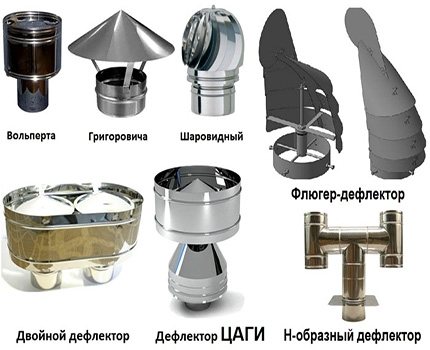

Types of chimney deflectors
Basically, chimney deflectors differ in shape and constituent elements. As you can see from the examples, products are usually made of stainless steel and galvanized steel. Models are round, square, open and closed cylinders. Also, the "top" of the device is different. In some, it has the shape of an umbrella, in others, the lid can be gable or hip, and in others it is completely flat or with decorative curly elements.
The diameter of the deflector for the chimney pipe can be 100-500 mm, the width of the diffuser varies from 240 to 1000 mm, the height of the device is 140-600 mm.
The deflector is connected to the chimney using brackets, bolts and a sealing tape. It is made of steel, the thickness of which is 0.5-1 mm. A spark arrester can also be installed. Usually the equipment is equipped with such a part, in case of a risk of a possible fire on the roof.


